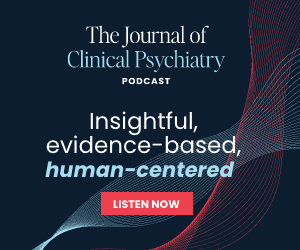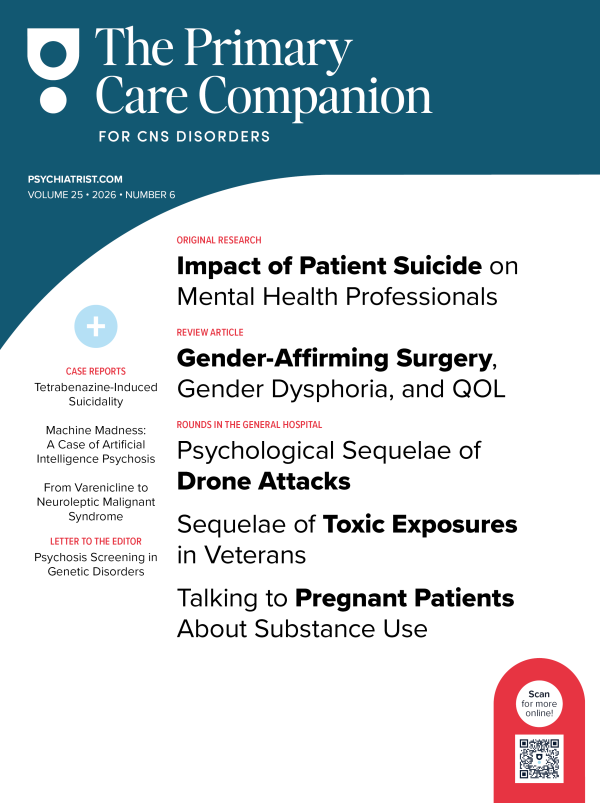Electroconvulsive therapy (ECT) administration in patients with thyroid dysfunction poses unique challenges.1 Hashimoto thyroiditis may manifest as acute psychosis in approximately 26% of cases and schizophrenia-like symptoms in about 2.2%.2 While thyroid dysfunction itself can precipitate psychiatric symptoms3 and catatonia,4 its effect on cardiovascular function can pose a risk for anesthesia induction in ECT. While normalizing thyroid function before ECT is preferred, urgent situations may necessitate immediate normalization.
Case Report
Ms A, a 28-year-old woman, had symptoms suggestive of schizophrenia since 2017 and presented to the hospital in October 2023 with worsening of symptoms following drug discontinuation for 1 year. Upon examination, she was fearful and uncooperative and had continuous self-muttering and catatonia (withdrawal, staring, mutism, mannerisms, posturing, and negativism) (Bush-Francis Catatonia Rating Scale [BFCRS] score: 12).5 She was admitted to the hospital. On evaluation, her thyroid-stimulating hormone (TSH) level was 53 mIU/L with a free triiodothyronine (fT3) level of 0.22 ng/dL and a free thyroxine (fT4) of 0.69 ng/dL (normal range TSH: 0.27–4.2 mIU/mL, free T3: 0.24–0.52 ng/dL, free T4: 0.93–1.7 ng/dL). Ultrasound of the thyroid revealed thyroiditis, and antithyroid peroxidase antibody was positive (1,000 IU/mL), suggestive of Hashimoto thyroiditis. Ms A underwent a thorough evaluation to exclude secondary causes of catatonia. Cerebrospinal fluid (CSF) cell counts and serum studies for infections (eg, cryptococcus, syphilis, leptospira, scrub typhus, brucella) and autoimmune conditions (including a detailed ANA profile) were all negative. CSF analysis and cell counts were within normal limits. These findings, along with a normal brain magnetic resonance imaging scan, support a diagnosis of primary catatonia.
Ms A was started on oral olanzapine 5 mg/d, gradually uptitrated to 20 mg/d along with intravenous (IV) lorazepam 2 mg twice daily and 50 μg/d oral levothyroxine supplementation. However, there was no improvement in the clinical status over the next 2 weeks, and the adherence with medications (for both psychotropics and oral levothyroxine) were intermittent. In the meantime, the repeat thyroid function revealed a TSH value of 88 mIU/L, fT3 of 0.2 ng/dL, and fT4 of 0.55 ng/dL, suggesting further worsening of her thyroid function. In view of inadequate response and continued poor oral intake, ECT was considered.
Ms A belonged to the category of moderate-severe hypothyroidism based on the low free thyroxine values.6 Since our hospital does not have a backup of in-house physicians, instead of IV levothyroxine, she was started on oral levothyroxine of 200 μg/d, as discussed with the endocrinologist. After 5 days of oral levothyroxine supplementation, serum TSH reduced to 12.7 mIU/L with normal fT3 (0.25 ng/dL) and fT4 (1.52 ng/dL). The patient was started on modified bifrontal ECT and continued the oral thyroxine of 200 μg/d with regular monitoring of pulse rate. Anesthesia was achieved using thiopentone 125 mg along with the muscle relaxant succinylcholine 25 mg. Continuous cardiac monitoring was done throughout the ECT procedure. After every ECT session, Ms A was monitored in a recovery unit with continuous cardiac and clinical monitoring for 45 minutes. After the fourth ECT session, her oral intake improved, and she became cooperative in taking medications. After being on 200 μg/d of levothyroxine for 12 days, her pulse rate was 130 beats/minute and TSH was 0.33 mIU/L. The dose of thyroxine was decreased to 100 μg/d, and tablet propranolol 40 mg/d was added for tachycardia. Over the next 2 days, her pulse rate decreased to 100 beats/ minute, propranolol was stopped, and ECT was continued as earlier.
Overall, Ms A received 11 bifrontal ECT sessions over 4 weeks. Her BFCRS score decreased from 12 to 3 after 11 ECT sessions; her Brief Psychiatric Rating Scale score (24 items, 1–7 rating) decreased from 88 to 39.7 In a previous report, ECT was found to be effective in treating psychiatric symptoms cooccurring with Hashimoto thyroiditis.8 In our case, normalization of thyroid levels might have also helped in the improvement of catatonic symptoms. She was discharged on olanzapine 25 mg/d. She has been in follow-up with our treatment team for the last 9 months and has maintained the improvement attained during inpatient care.
Conclusion
High-loading doses of oral levothyroxine rapidly normalized thyroid hormones, which helped in earlier initiation of ECT. A multidisciplinary approach with input from endocrinologists and anesthetists and regular monitoring of the adverse effects of high-dose thyroxine is essential.
Article Information
Published Online: July 29, 2025. https://doi.org/10.4088/PCC.25cr03914
© 2025 Physicians Postgraduate Press, Inc.
Prim Care Companion CNS Disord 2025;27(4):25cr03914
Submitted: January 25, 2025; accepted April 23, 2025.
To Cite: Bhatt P, Jayasankar P, Ramachandraiah R, et al. High-dose oral thyroxine to optimize thyroid function before electroconvulsive therapy: a case of schizophrenia with comorbid Hashimoto thyroiditis. Prim Care Companion CNS Disord 2025;27(4):25cr03914.
Author Affiliations: Department of Psychiatry, National Institute of Mental Health and Neurosciences, Bengaluru, India (Bhatt, Jayasankar, Ramachandraiah, Bharadwaj, Kumar); Centre for Brain and Mind, National Institute of Mental Health and Neurosciences, Bengaluru, India (Jayasankar); Samatvam Endocrinology Diabetes Centre, Bengaluru, India (Chithra).
Corresponding Author: Vijay Kumar, MD, Department of Psychiatry, National Institute of Mental Health and Neurosciences, Bengaluru 560029, India ([email protected]).
Relevant Financial Relationships: None.
Funding/Support: None.
Patient Consent: Consent was received from the patient to publish the case report, and information, including dates, has been de-identified to protect patient anonymity.
References (8)

- Hermida AP, Mohsin M, Marques Pinheiro AP, et al. The cardiovascular side effects of electroconvulsive therapy and their management. The J ECT. 2022;38(1):2–9.
- Menon V, Subramanian K, Thamizh JS. Psychiatric presentations heralding Hashimoto’s encephalopathy: a systematic review and analysis of cases reported in literature. J Neurosci Rural Pract. 2017;8(2):261–267.
- Spiegel DR, Jahelka C, Shelton M, et al. A case and differential diagnosis of catatonia in a patient with hypothyroidism due to levothyroxine nonadherence. Prim Care Companion CNS Disord. 2024;26(4):56170.
- Rasmussen MJ, Robbins H, Fipps DC, et al. Neuropsychiatric sequelae of thyroid dysfunction: evaluation and management. Prim Care Companion CNS Disord. 2023;25(6):23f03570.
- Bush G, Fink M, Petrides G, et al. Catatonia. I. Rating scale and standardized examination. Acta Psychiatr Scand. 1996;93(2):129–136. PubMed CrossRef
- Malhotra B, Bhadada SK. Perioperative management for non-thyroidal surgery in thyroid dysfunction. Indian J Endocrinol Metab. 2022;26(5):428–434.
- Overall JE, Gorham DR. The Brief Psychiatric Rating Scale (BPRS): recent developments in ascertainment and scaling. Psychopharmacol Bull. 1988;22:97–99.
- Rodríguez-Ramírez S, Trejo-Terreros V, Téllez-Martínez JA, et al. Response to steroids and electroconvulsive therapy in Hashimoto’s encephalopathy: case report and literature review. Rev Mex Neurocienc. 2014;15(3):171–174.
Please sign in or purchase this PDF for $40.





